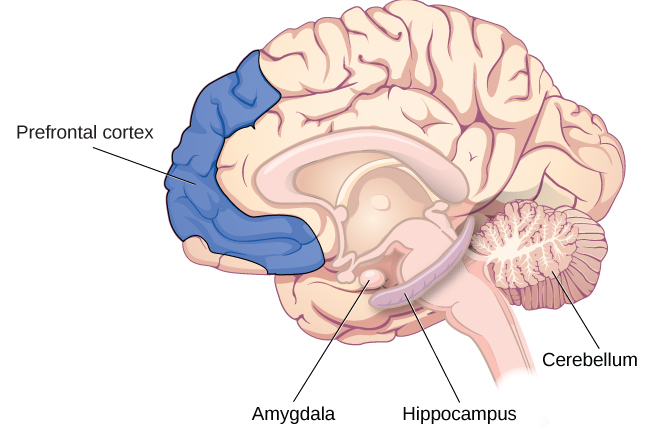59 7.2. Parts of the Brain Involved with Memory
The storage of long-term memories (regardless of their type) involves creating and strengthening connections between neurons in the brain. Each thought, feeling, or behavior is associated with a circuit or network of neurons that are activated at the same time. If neurons within the circuit are frequently and repeatedly stimulated, then it becomes easier to reactivate the circuit in the future. This process is known as long-term potentiation (LTP; Lynch, 2004). Long-term potentiation happens gradually. For example, as soon as you start learning a new skill – such as learning to play the guitar— you slowly modify existing neural circuits and create new ones. Each time you practice, you strengthen the connections between the neurons that you are using. The more you practice the guitar, the stronger (more potentiated) the connections become, and the easier it gets. If you practice a lot, the memory can become consolidated, making it relatively permanent, allowing you to play the guitar for the rest of your life. Memory consolidation involves further synaptic changes in multiple parts of the brain (Alberini et al., 2013). Repetition and attention are essential for LTP to occur, otherwise the connections between neurons can weaken and may even disappear. Under some circumstances, this weakening process is quite useful because it allows our brains to discard information that is likely not very important to us because we have not practiced or tried to retrieve it. When we are learning something new, paying close attention and practicing, signals to our brains that something is important.
Different parts of your brain are important for different kinds of memory. In this section, we will focus on the role of the hippocampus, the amygdala, the cerebellum and basal ganglia, and the prefrontal cortex (Figure 7.10).

Hippocampus
The hippocampus (and nearby hippocampal-related structures) play an essential role in the consolidation of explicit memories. Hippocampal structure damage leaves us unable to store new episodic memories. One famous patient, known for years as H. M. to protect his identity, had hippocampal structures removed from both hemispheres of his brain when he was 27 years old, in an attempt to help control the epileptic seizures he had been suffering since childhood (Corkin et al., 1997). The surgery stopped the seizures, but he was not able to form new explicit memories for the rest of his life. However, he was able to remember everything from his childhood and up till 2-3 years before the surgery. It is thought that the hippocampal structures play a role in encoding, storing, and retrieving memories. The hippocampal structures are thought to keep a record of the neural circuits that are active in many different parts of the brain during encoding. During retrieval, the hippocampal structures reactivate the same circuitry. Over time, as memories become consolidated, the hippocampal structures are no longer needed to activate the circuits, they become active automatically. This is why H.M. did not lose most of his memories from before the surgery, only the more recent ones. H.M. was able to learn new implicit memories, such as new procedural memories—which shows that these types of memories are governed by other brain areas. For example, he learned to accurately trace the outline of a shape while looking in a mirror (mirror-tracing). He did the activity multiple days in a row and improved over time, however, on each occasion he never remembered doing it previously (Corkin, 1968; Squire, 2009).
The posterior part of the hippocampus is also important for spatial memory, e.g., remembering your way to school from home and other routes (Clark et al., 2000). London taxi drivers who rely heavily on spatial memory in their daily lives have larger than average posterior hippocampal structures. Children from hunter-gatherer societies (e.g., Australian aborigines, and the Tsimané people who live in the Amazon) who grow up learning to track animals and forage, also develop superior visuospatial skills (Wang, 2021). It is highly likely that they too, have larger than average hippocampi.
Amygdala
The main job of the amygdala is to process and regulate emotions. The amygdala also plays a part in how emotional memories are formed and stored. Emotional memories are often easier to encode than other memories, this is because the amygdala is activated when we experience strong emotions. This is why emotional memories are often so memorable. Similarly, when we remember an emotional situation, the amygdala is often reactivated and we may re-experience the emotions (McGaugh, 2003). The amygdala is essential for fear conditioning to develop. Damage to the amygdala prevents people and animals from learning to avoid dangerous situations and stimuli (Josselyn, 2010).
Cerebellum and Basal Ganglia
Although the hippocampus is important for explicit memories, implicit memories (procedural memory, motor learning, and classical conditioning) are mediated by other parts of the brain. The amygdala is important for fear-conditioning, but other classically conditioned behaviors, such as learning to blink to a stimulus that comes before a puff of air to the eye, is dependent on the cerebellum (Steinmetz, 1999; Green & Woodruff-Pak, 2000). Procedural memories are highly dependent on activation of the basal ganglia (these are a group of subcortical structures deep within the brain) and to a lesser extent, the cerebellum also plays a role in procedural memories (Ullman, 2004).
Prefrontal Cortex
The prefrontal cortex (PFC) is important for many aspects of memory. For example, during most WM tasks, there is strong activation of the PFC. The PFC is also likely to play a role in encoding information, by directing our attention to different stimuli in the environment. The PFC is also activated when we retrieve semantic and episodic memories, which may be explained in part by the presence of strong PFC-hippocampal connections (Nyberg et al., 2003).
Link to Learning
In this TED Talk called “A Mouse. A Laser Beam. A Manipulated Memory,” Steve Ramirez and Xu Liu from MIT talk about using laser beams to manipulate fear memory in rats. Find out why their work caused a media frenzy when it was published in a leading scientific journal called Science.
Flashbulb memories
Our ability to relatively easily encode events that arouse very strong emotions is linked to a particular type of memory, called a flashbulb memory. The word was used to indicate the memory is like a picture (taken with a flash). Flashbulb memories are unusually detailed and vivid episodic memories of unexpected, highly emotionally arousing events, that are frequently of historical significance (Figure 7.11). In recent United States history, flashbulb memories might include the January 6th 2021 attack on the United States Capitol, the mass shooting of many LGBTQ individuals at the Pulse nightclub in Orlando on June 12, 2016, and the 9/11 terrorist attacks in 2001. Many people continue to have very strong, often emotional memories, about these events.
In addition to the biological mechanisms that facilitate the encoding of unexpected emotional events, there are many other factors that likely contribute to the memorability of flashbulb events. Firstly, people engage in frequent discussion about flashbulb events and are more likely to spend a lot of time thinking about them, compared to more everyday events. People are also likely to be inundated by coverage of the events on news and social media. These factors contribute to the perceived memorability of a flashbulb memory. Flashbulb memories seem to have a particularly long duration. A Pew Research Center survey (2011) found that for Americans who were age 8 or older at the time of 9/11 terrorist attacks, 97% can recall the moment they learned of this event, even a decade after it happened.
Although most flashbulb memory research has focused on historically significant, negative events, strictly speaking, any surprising highly emotional event (positive or negative, personal or global) could become a flashbulb memory (Brown & Kulik, 1977; Hirst & Phelps, 2016). Although flashbulb memories are typically detailed and vivid, they are not always accurate.

Dig Deeper
Inaccurate and False Memories
Even flashbulb memories for important events can become less accurate with the passage of time. For example, four months after the terrorist attacks of 9/11, President George W. Bush misremembered how he had first heard about the attacks. He said:
“I was sitting there, and my Chief of Staff—well, first of all, when we walked into the classroom, I had seen this plane fly into the first building. There was a TV set on. And you know, I thought it was pilot error and I was amazed that anybody could make such a terrible mistake.” (Greenberg, 2004, p. 2)
However, there was no live footage of the plane hitting the building. This was the event that alerted people, including the TV stations, who then quickly went to the scene.
George W. Bush is not the only person who has inaccurate flashbulb memories, they are quite common (Talarico & Rubin, 2007). As we pointed out at the beginning of the chapter, memory is not like a video recording. Human memory, even flashbulb memories, can be vulnerable to change and misinformation. Every time we retrieve a memory, we reconstruct it. Do you have a flashbulb memory? Who were you with and what were you doing? What did you talk about? Can you contact those people you were with? Do they have the same memories as you or do they have different memories?
